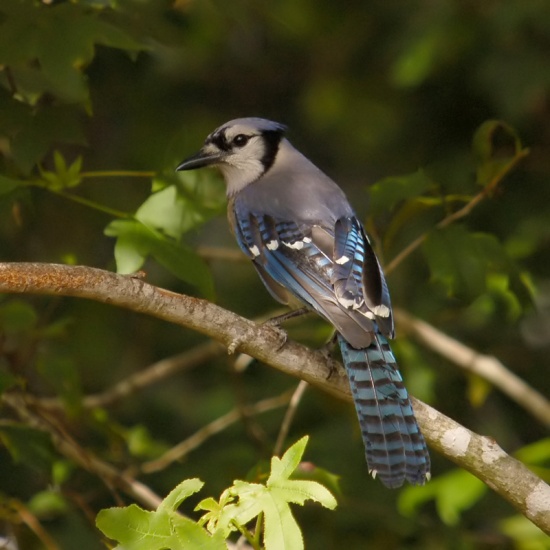- Cyanocitta cristata
Identification
25–30 cm (9¾-11¾ in)
- Predominantly lavender-blue to mid-blue feathering from the top of the head to midway down the back
- Pronounced crest
- Colour changes to black, sky-blue and white barring on the wing primaries and the tail
- Off-white underside
- Black collar around the neck and sides of the head
- White face
- Soles of feet are yellow as seen in this picture
Distribution
Eastern side of North America from northest Newfoundland to southest Florida, western Texas and Midwestern United States, and north to central Alberta. West of the Rockies, it is replaced by the closely related Steller's Jay. Blue Jay is slowly spreading westward.
Although this bird is generally found year-round through most of its range, some northern birds do move into the southern parts of the range. These birds migrate in the daytime.
Taxonomy
Subspecies
Four subspecies are recognized1:
- C. c. bromia :
- C. c. cristata:
- Central eastern and southeastern US
- C. c. cyanotephra:
- C. c. semplei:
- Southern Florida
Habitat
Chiefly oak forest, but now also city parks and suburban yards, especially where oak trees predominate. It is mainly a bird of mixed woodland, including American beech and various oak species.
Behaviour
Breeding
The nest is built by both adults. The four or five eggs are incubated by the female for about 16 or 18 days. Both parents feed the young, which fledge between 17-21 days. Monogamous.
Diet
They are Omnivorous feeding on acorns and beech mast. Also seeds, berries and fruit. They will also take eggs and nestlings, scraps of meat and small invertebrates. Garden feeder visitor for peanuts and suet.
Vocalisation
- A raucous jay-jay
- Harsh cries, and a rich variety of other calls.
- One is almost identical to the scream of the Red-shouldered Hawk.
- queedle-queedle often referred to as the "rusty pump" owing to its squeaky resemblance to the sound of an old hand-operated water pump.
- a high-pitched jayer-jayer call that increases in speed as the bird becomes more agitated.
References
- Clements, J. F., T. S. Schulenberg, M. J. Iliff, S. M. Billerman, T. A. Fredericks, B. L. Sullivan, and C. L. Wood. 2019. The eBird/Clements Checklist of Birds of the World: v2019. Downloaded from http://www.birds.cornell.edu/clementschecklist/download/
- AvianWeb
- BF Member observations
- Marzluff, J. (2020). Blue Jay (Cyanocitta cristata). In: del Hoyo, J., Elliott, A., Sargatal, J., Christie, D.A. & de Juana, E. (eds.). Handbook of the Birds of the World Alive. Lynx Edicions, Barcelona. (retrieved from https://www.hbw.com/node/60692 on 12 March 2020)
Recommended Citation
- BirdForum Opus contributors. (2025) Blue Jay. In: BirdForum, the forum for wild birds and birding. Retrieved 1 May 2025 from https://www.birdforum.net/opus/Blue_Jay
External Links
Search the Gallery using the scientific name:
GSearch checked for 2020 platform.1






